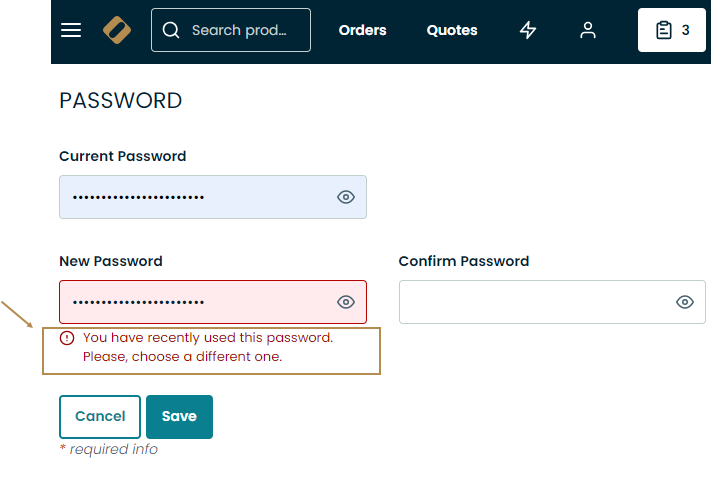Important
You are browsing documentation for version 5.1 of OroCommerce, supported until March 2027. Read the documentation for the latest LTS version to get up-to-date information.
See our Release Process documentation for more information on the currently supported and upcoming releases.
Configure Global Customer User Settings
Customer User settings can be configured globally, per organization, and per website.
To change the default customer user configuration settings globally:
Navigate to System > Configuration in the main menu.
Select Commerce > Customer > Customer Users in the menu to the left.
Note
For faster navigation between the configuration menu sections, use Quick Search.
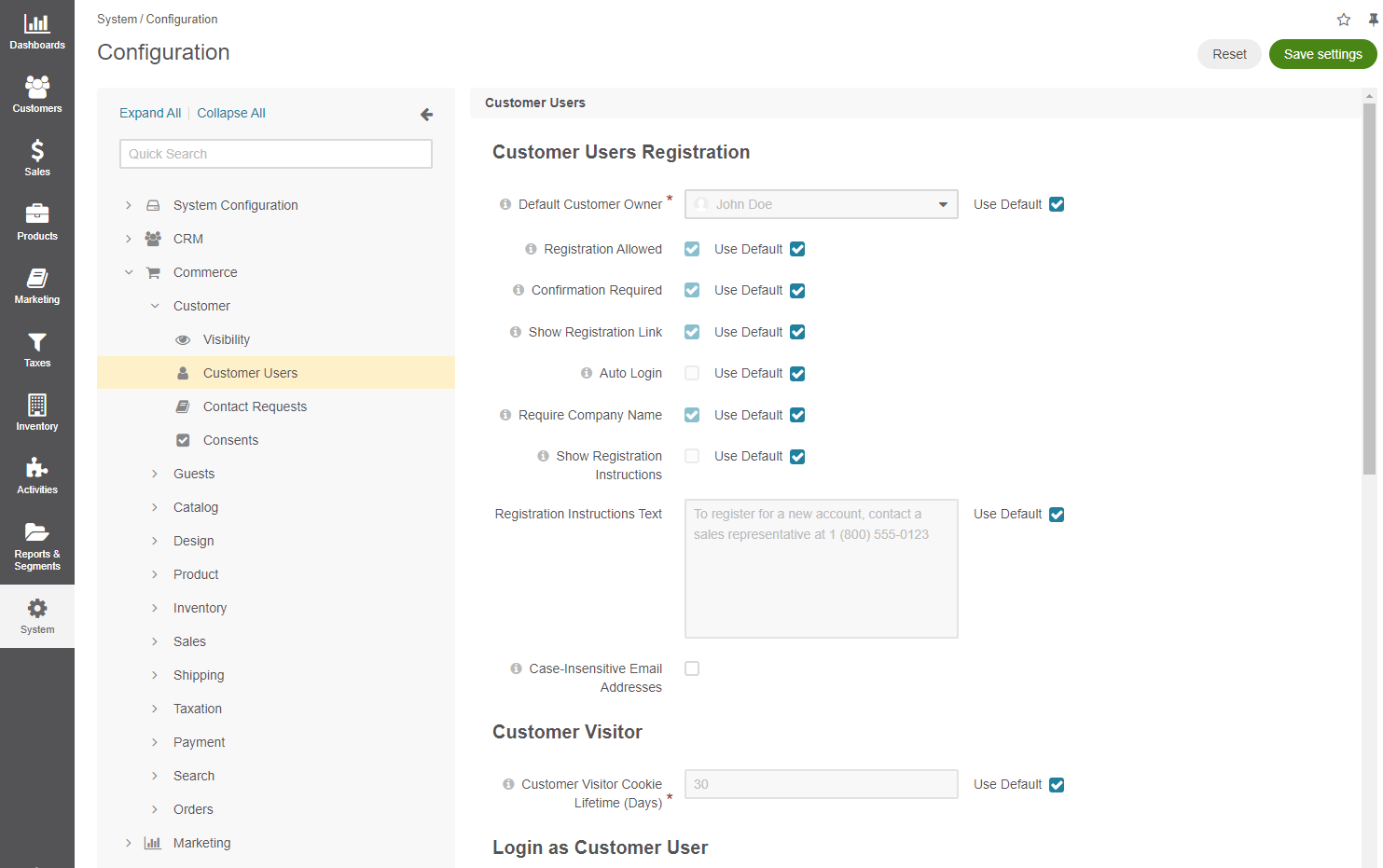
To customize any of the options for customer users:
Clear the Use Default box next to the option.
Select the new option.
In the Customer Users Registration section, configure the following options:
Default Customer Owner — Service information that determines which user has full access to managing and viewing customer information. Usually, this is the default customer administrator or the administrator assigned to the customer. Applies to the customers created in the back-office as well as to those who register on the OroCommerce website.
Registration Allowed — Enables/disables registration of new customers from the storefront login screen.
Confirmation Required — Enables/disables the email confirmation step following user registration.
Show Registration Link — Shows/hides the registration link from the storefront login screen. The link is next to the Sign In link in the top bar.
Auto Login —Enables/disables customer users to login after registration or email confirmation. Disabled by default.
Required Company Name — Shows/hides the company name field in the registration form in the storefront. Required for individual customers who do not belong to any company.
Show Registration Instructions — Enables/disables registration instructions in the storefront login page. This option is disabled by default.
Registration Instructions Text — If Show Registration Instructions is enabled, the text provided in the field is displayed in the storefront login page.
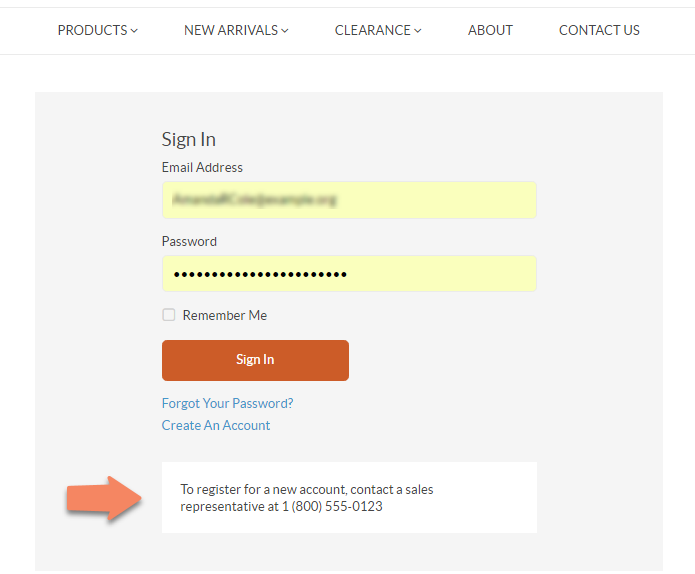
Case-Insensitive Email Addresses — If this option is enabled, the letter case is ignored when comparing email addresses. For example, john.doe@example.com and John.Doe@example.com are treated equally. By default, the option is disabled. The identical option for back-office users is managed here. Keep in mind that the uniqueness of email addresses and personal data is checked only for the registered users. It means that no two users can have identical personal information unless they are customer visitors (guest users). Multiple guest customers are allowed to have exactly the same data, including email addresses.
In the Customer Visitor section, configure the options for the anonymous users:
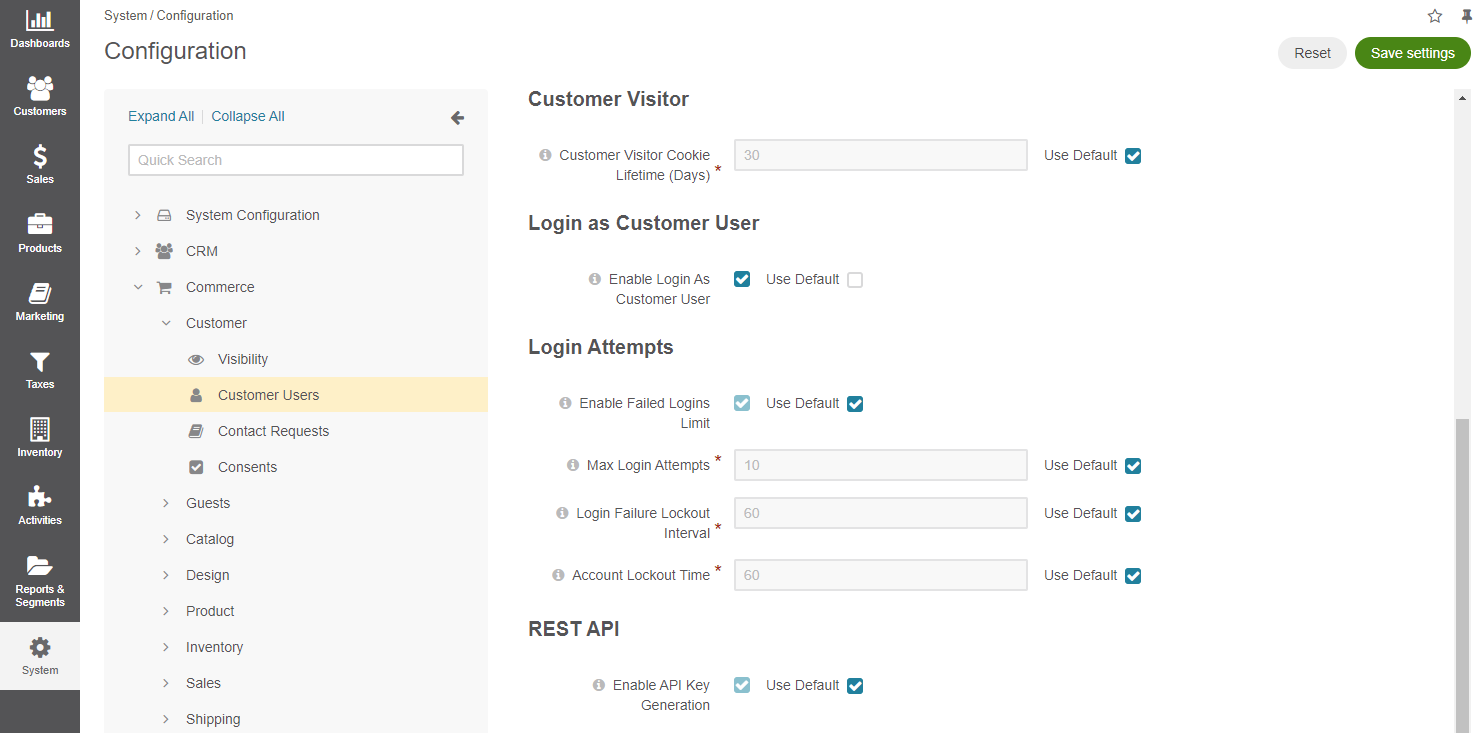
Customer Visitor Cookie Lifetime (Days) — Once the provided period expires, active customer visitor (anonymous user) sessions will be reset. Keep in mind that the uniqueness of email addresses and personal data is checked only for the registered users. It means that no two users can have identical personal information unless they are customer visitors (guest users). Multiple guest customers are allowed to have exactly the same data, including email addresses.
Create Customer Visitors Immediately (available starting from OroCommerce version 5.1.14) — This feature controls whether customer visitor accounts are automatically created for all guest users who access the storefront.
When enabled, visitor accounts are created automatically for every guest user, regardless of whether they interact with the website.
When disabled, visitor accounts are only created for users who perform meaningful actions (e.g., adding items to the shopping list or proceeding to checkout). This reduces database load by avoiding unnecessary data storage for bots, idle visitors, or users who quickly leave without interacting.
In the Login as Customer User section, configure the option for customer users. Keep in mind that this feature is available in the Enterprise edition.
Enable Login As Customer User — The option enables back-office users with the Login as Customer User role capability assigned to them to temporarily sign into the OroCommerce storefront and operate it as a specific customer user (i.e., impersonate a customer user). This option is disabled by default. User impersonation is also available at the organization level.
In the Login Attempts section, configure the following options:
Enable Failed Logins Limit — Defines whether a user can be locked out when the max number of login attempts is reached. By default, the option is enabled.
Max Login Attempts — The number of attempts within the login failure lockout interval that a user has to authenticate before they are locked out. By default, the number is set to 10.
Login Failure Lockout Interval — The time in minutes in which failed login attempts are counted. If one failed login attempt is followed by the second failed attempt within this lockout interval, the failed login count starts. The user will be locked out if they reach the maximum number of failed login attempts. Set zero (0) to count failed login attempts globally. By default, it is set to 60 minutes.
Account Lockout Time — The time in minutes that indicates how long the user has before they are locked out of the system if they reach the maximum number of failed login attempts. Set zero (0) to disable automatic unlock. By default, it is set to 60 minutes.
In the REST API section, configure the following options:
Enable API Key Generation — Enable/disable automatic generation of API access keys for new customer users.
In the Cookies Banner section, you can enable a cookie consent banner. A cookie consent banner is the cookie warning that pops up on websites when a user visits the site for the first time. This banner lets visitors know that their data is being collected and get their consent to use the data. The CookieConsentBannerBundle allows to show such warning to the user.
If the application was installed without demo data, the banner is disabled. Configure the following options to enable cookie consent banner on the global level:
Show Banner — Select the checkbox to display the cookie consent banner to the website’s visitor.
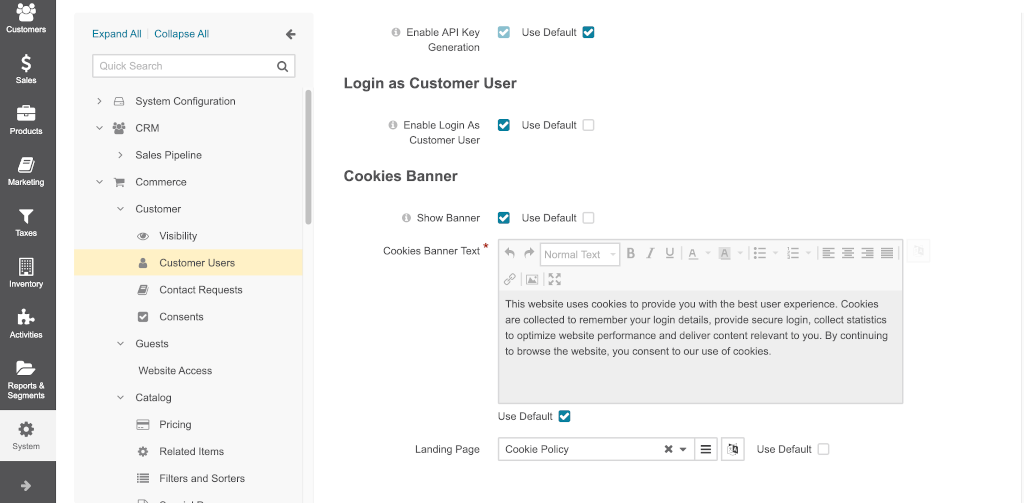
Cookies Banner Text — Provide the message of the cookie banner. To edit the text for a specific language, click the language button and edit the text for the needed language.

Landing Page - Select the landing page with cookie policy of the application, if any. This landing page will be highlighted as a link on the banner. To translate the landing page title to the specific language, click the language button and edit the title as required.
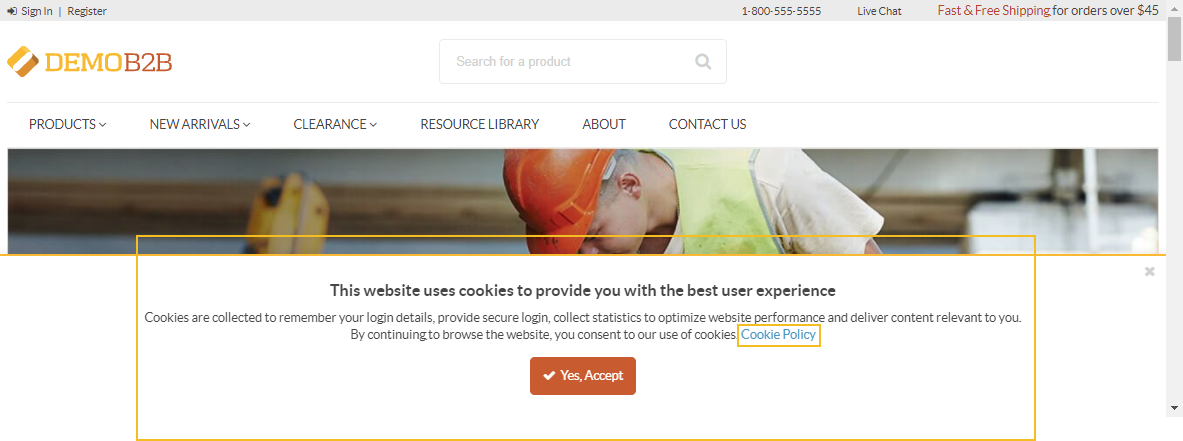
Click Save Settings.
Password Change Policy
Note
This is a Commerce Enterprise feature.
You can enforce a password change policy to increase your application’s security and request that your customer users change their passwords after a certain period.
To enable the feature per customer user:
Navigate to System > Configuration in the main menu.
Select Commerce > Customer Users in the menu to the left.
Select the Enable Password Change Policy checkbox to enable the feature.
By default, the password is changed every 30 days. You can change the default number of days by toggling the option Maximum Password Age (Days).
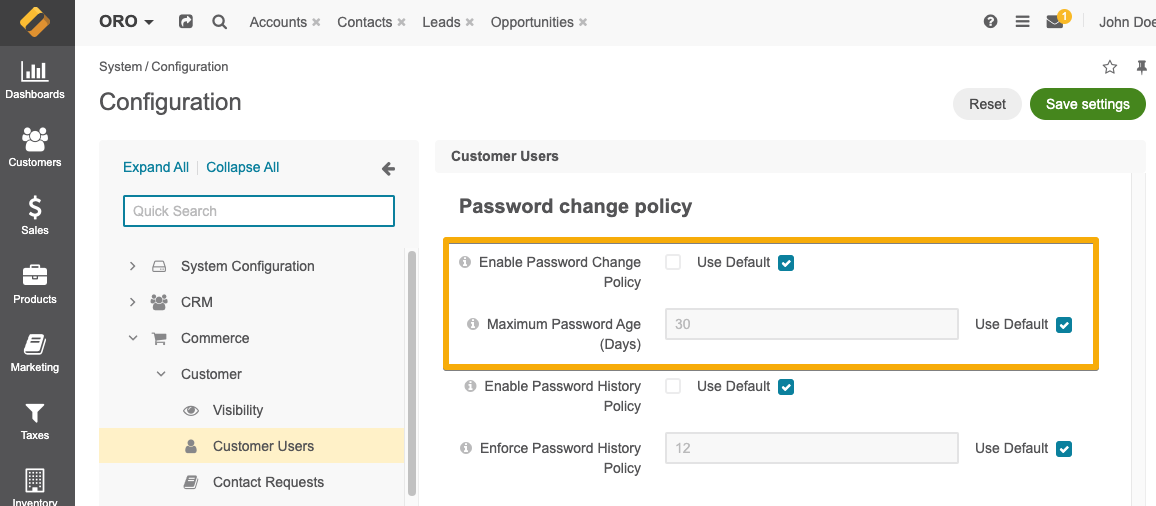
Once the feature is enabled, customer users will receive email notifications 7, 3, and 1 days before the password expires with a link to change their password.
Seven days before the password expires, the customer user will start getting flash notifications on each login, prompting them to change their password.

As soon as the password expires, the customer user will receive an email with the link to change the password. From that moment, they will only be able to log in if they have updated their password. In this case, the status of the customer user password in the back-office changes to Expired. It will return to Active once the customer user changes the password.
You can change the contents of email notifications by updating the customer_user_expired_password and customer_user_mandatory_password_change email template of the Customer User entity.
Password History Policy
Note
This is a Commerce Enterprise feature.
You can enable the Password history policy to prevent customer users from reusing the password they have already used previously.
To enable the feature:
Navigate to System > Configuration in the main menu.
Select Commerce > Customer Users in the menu to the left.
Select the Enable Password History Policy checkbox to enable the feature.
By default, the system collects the last 12 previously used passwords, but you can change this number by toggling the option Enforce Password History Policy.
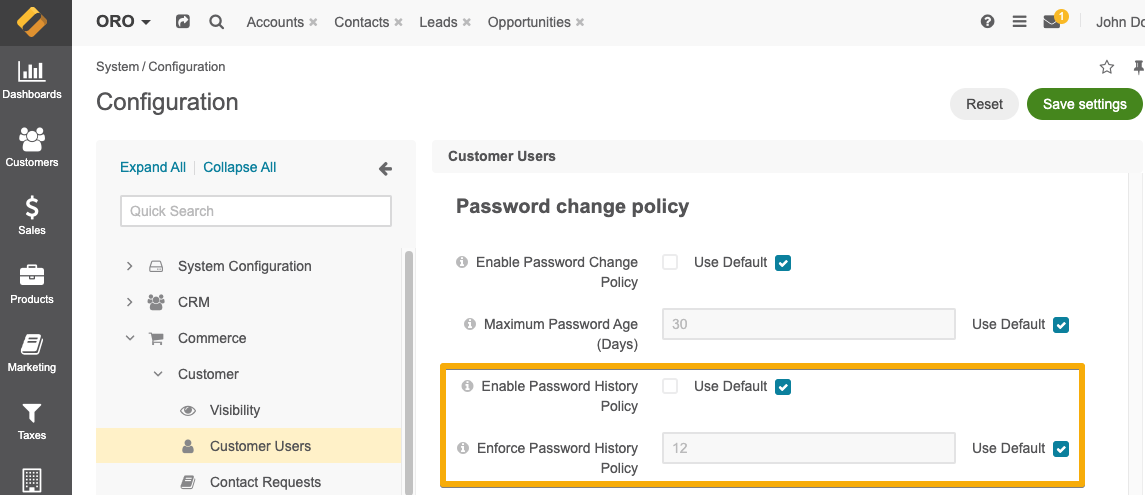
Once the feature is enabled, customer users will no longer be able to reuse their older passwords. If they try to, they will get the following message:
